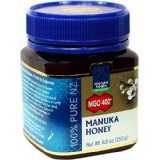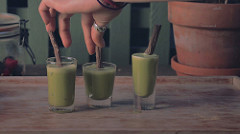Where does it come from?
Manuka Honey is produced by honey bees that collect nectar from the Manuka Bush or Leptospermum Scoparium, a tea tree indigenous to New Zealand.
New Zealand has one of the highest standards of organic certification for honey in the world. In fact one of the unique things that New Zealand does that many other countries dont is insist that the bee hives, the land they are on and the surrounding land for a three-five mile radius is certified organic. The reason for this is that studies (1&2) have shown that bees can travel up to and sometimes over 1.7km (thats 1-2 miles to me and you) to feed and collect pollen, meaning that pollen from GMO crops and pesticide sprayed crops can be brought into the hive contaminating the honey.
What makes it unique?
Once the bees have gathered the nectar they take it back to the hive where they add an enzyme called glucose oxidase to preserve the honey, which then slowly releases small amounts of the antibacterial agent hydrogen peroxide into the honey.
So how does this differ from other honey? Whilst all honey contains hydrogen peroxide this varies in potency by almost 100 fold across all types of honey, and when exposed to heat and light the enzyme that produces hydrogen peroxide is destroyed, and so is the antibacterial property of the honey.
Professor Peter Molan at the Honey Research Unit of Waikato University, New Zealand, has discovered that what makes Manuka Honey unique is the presence of Methylglyoxal (MGO) in high quantities (between 100 and 1000mg/Kg). This non-peroxide ingredient is what gives this honey its unique antibacterial, anti microbial, antiviral, antioxidant, antiseptic, anti-inflammatory and anti fungal properties. A Methylglyoxal level of 400 mg/kg and higher in the honey gives it the power to destroy a very large number of destructive microorganisms, viruses and bacteria.

Another unique aspect of MGO is that it is stable, meaning that it is not broken down by heat or light, or the catalase enzyme present in body tissue, hence its unique ability to heal wounds. It also does not require dilution or oxygen to become active meaning that it can work in wound dressings, internally (in the digestive tract/ stomach), and at a more potent level. This unique property has been termed the Unique Manuka Factor (UMF).
But beware research has shown not all Manuka honey contains UMF and not all are strong enough to have a therapeutic effect. UMF needs to be 16+ at least to have significant anti-bacterial and healing properties and must be active. So the words you are looking for on the label of your tub of Manuka Honey are organic, active, and UMF of between 16+ and 24+. The higher the UMF level, the higher the health benefits.
So What are the Benefits of Manuka Honey?
Most people will know that Manuka honey has antibacterial properties, and that it’s good for their health but most wont be sure why this is or how it works. Professor Molan at Waikato University Honey Research Unit in New Zealand has been researching the properties and benefits of it for over 28 years and has made some interesting discoveries the latest of which is that Manuka Honey has anti-ageing properties as it is able to stimulate collagen synthesis in the skin helping to plump out fine lines and wrinkles.
It is also anti-inflammatory making it a great organic skincare ingredient. It can help to heal conditions such as acne, stomach ulcers, arthritis, and eczema. It can be both taken internally and applied topically to the skin. This is because Manuka honey’s high sugar content creates a waterless environment in which the bacteria that are infecting a wound are unable to survive. Also, thanks to the presence of an enzyme called glucose oxidase, it is acidic, which adds to its unique antibacterial properties. In fact Christie Hospital in Didsbury is now using this honey in the treatment of patients with mouth and throat cancers. Of course the most well known benefit of Manuka Honey is that it is anti-bacterial. The Center for Disease Control and Prevention (CDC) in the US has stated that at least 70% of bacteria are now immune to at least one kind of antibiotic. No bacteria are known to have developed a resistance to Active Manuka Honey.
Manuka Honey destroys bacteria by drawing all the moisture out of the cells. It damages the environment that bacteria multiples in and in turn kills bacteria. Medical researchers in Trenton New Jersey are now producing a Medical Gauze made with this Honey. In the case of MRSA, studies show that Manuka Honey interferes with the separation process when the bacteria try to multiply thus, preventing MRSA from spreading. Manuka Honey has also been shown to increase good bacteria in the stomach helping to aid digestion and strengthen the immune system.
Why are beauty salons using it in beauty treatments:
* Anti-ageing benefits – when combined with Facial Rejuvenation Acupuncture. It also creates a clean sterile surface for acupuncture on the face. Acupuncture, anti-aging massage techniques and Manuka Honey combined give the most amazing luminosity to the skin post treatment, and rapid results.
* Deeply cleansing the skin the technique used gently draws impurities from the skin reducing the need for over-squeezing the skin during manual extractions. For pre-extractions it loosens impurities and helps prepare the skin for deeper cleansing. If the skin is not prepared correctly extractions can be uncomfortable and damage the skin. Using a Manuka Honey cleansing technique is a great alternative for those with sensitive skin who still like a deep cleanse but don’t like traditional manual extractions.
* Anti-inflammatory and healing – soothes inflamed skin for acne and rosacea suffers. Great after extractions too.
The Author is a fan of organic skin care and has been using it for more than 10 years. Marie works as an organic skincare buyer for a boutque beauty store sourcing organic make up and natural and organic beauty products

